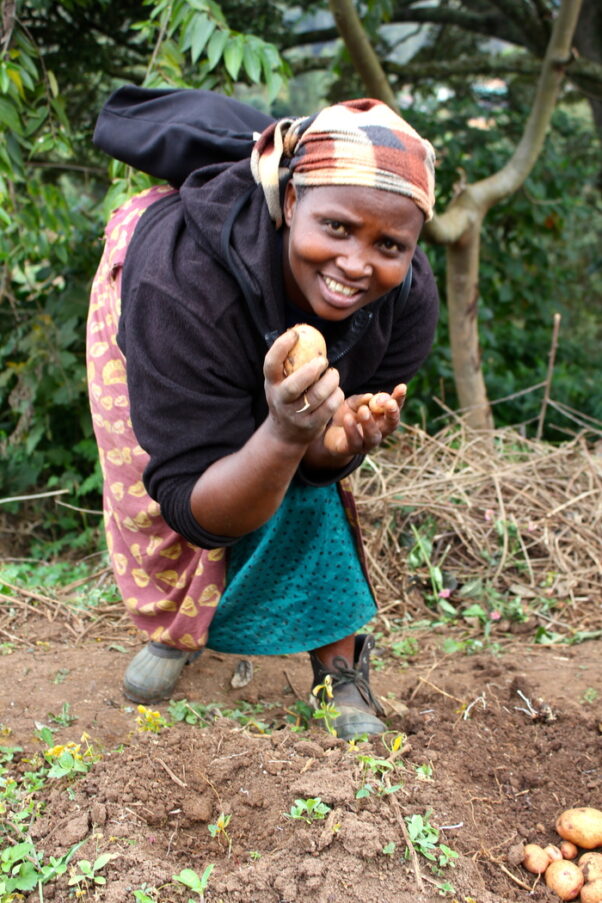As CGIAR puts the finishing touches to its forthcoming Genetic Innovation Gender Strategy, Vivian Polar, Gender, and Innovation Specialist at the International Potato Center (CIP) sets out how gender inclusivity is being integrated into crop breeding programs and why it matters.

Genetic innovations in crop breeding over the last decades have been a game-changer, increasing yields in farmers’ fields by up to 60% across a whole range of food security crops like potato, millet, and common bean. Continuing to develop and release varieties to help farmers withstand today’s challenging conditions including climate change, extreme weather, soil degradation, and novel crop pests and diseases is increasingly urgent. The good news is that we are making great technological strides that speed up the process and reduce costs so that farmers can benefit more quickly. Yet women are still missing out compared to men when it comes to new varieties that meet their needs even though they produce more than 40% of global agricultural output. It remains an enormous gap.
While CGIAR has considered gender inclusion in its breeding programs in the past, what is exciting now is that we will do so systematically, embedding it into the breeding pipeline. Gender inclusivity is about ensuring that all women have access to the varieties they need, including those in vulnerable parts of the world who farm in marginal conditions, in situations where malnutrition and poverty are high, and that have limited access to resources. Beneficiary needs including the needs of both men and women will dictate priorities, from the start of the process through to delivery of the new varieties to farmers. This market intelligence approach we hope will increase the adoption of new varieties by both women and men – in 2010, only a third of crops grown by sub-Saharan farmers were the latest varieties, and for women, the uptake can be as low as 5 percent.
When understanding what drives adoption with a gender lens, we know that in general women are more focused on traits that relate to household food security and nutrition, such as cookability, ease of preparation, and taste, whereas men are tasked with generating income, so are looking for traits that related more to yield, reduced risk of crop failure and marketability. If we dig down, we find that like most things, the reality is more complicated. For example, women also need varieties that the children will eat and that are also adapted to thrive in poor soils, without little need of irrigation or fertilizer. It is time to start systematically listening and learning so we are better placed to find the gaps and innovate to fill them.
That is not to say that gathering information to inform, initiate, and identify these gender gaps will be easy. There are many data gaps to fill so we can measure progress and impact. It is not enough to note when gathering data that a respondent is male or female, and perhaps their age group. We need to know more about what drives their choices, and what gaps need to be filled to meet their needs, or how we expect that the new varieties will be adopted, and their benefits delivered where they are most needed.
At the same time, we need to be realistic about what we can achieve. Although it is difficult for us to address some underlying social structures through breeding research, we can make sure that when it comes to the way we do research, women’s voices are heard and acted upon. That might mean changing how we gather feedback from women, for example, holding meetings in a local community in a culture where women may face travel restrictions or using local languages. We may work with the men so they better understand the benefits of women’s participation and can encourage them. It means ensuring when disseminating new varieties that we make sure women have equitable access to them. We need to adapt how we do research to the local context and try and think of new ways to reach out. For example, in a project to promote new varieties of biofortified iron-rich potatoes in the High Andes, we mixed our communication efforts by putting posters about its nutritional benefits close to the farmers’ field where the men would normally congregate, and information about agricultural practices for improved yields at the health center where the women gather. We also have the Seed Equal initiative that has developed a full work package to address equitable access to seed by diverse segments of the population including specifically targeting women.
What we always need to remember is that our goal is to transform food systems to include women, not because it’s a donor requirement, but because it is critical to achieve development outcomes so that no one is left behind.
By Vivian Polar
